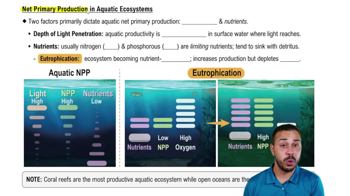True or false: The corpus luteum is retained upon implantation due to the presence of the hormone human chorionic gonadotropin (hCG).
Table of contents
- 1. Introduction to Biology2h 42m
- 2. Chemistry3h 40m
- 3. Water1h 26m
- 4. Biomolecules2h 23m
- 5. Cell Components2h 26m
- 6. The Membrane2h 31m
- 7. Energy and Metabolism2h 0m
- 8. Respiration2h 40m
- 9. Photosynthesis2h 49m
- 10. Cell Signaling59m
- 11. Cell Division2h 47m
- 12. Meiosis2h 0m
- 13. Mendelian Genetics4h 44m
- Introduction to Mendel's Experiments7m
- Genotype vs. Phenotype17m
- Punnett Squares13m
- Mendel's Experiments26m
- Mendel's Laws18m
- Monohybrid Crosses19m
- Test Crosses14m
- Dihybrid Crosses20m
- Punnett Square Probability26m
- Incomplete Dominance vs. Codominance20m
- Epistasis7m
- Non-Mendelian Genetics12m
- Pedigrees6m
- Autosomal Inheritance21m
- Sex-Linked Inheritance43m
- X-Inactivation9m
- 14. DNA Synthesis2h 27m
- 15. Gene Expression3h 20m
- 16. Regulation of Expression3h 31m
- Introduction to Regulation of Gene Expression13m
- Prokaryotic Gene Regulation via Operons27m
- The Lac Operon21m
- Glucose's Impact on Lac Operon25m
- The Trp Operon20m
- Review of the Lac Operon & Trp Operon11m
- Introduction to Eukaryotic Gene Regulation9m
- Eukaryotic Chromatin Modifications16m
- Eukaryotic Transcriptional Control22m
- Eukaryotic Post-Transcriptional Regulation28m
- Eukaryotic Post-Translational Regulation13m
- 17. Viruses37m
- 18. Biotechnology2h 58m
- 19. Genomics17m
- 20. Development1h 5m
- 21. Evolution3h 1m
- 22. Evolution of Populations3h 53m
- 23. Speciation1h 37m
- 24. History of Life on Earth2h 6m
- 25. Phylogeny2h 31m
- 26. Prokaryotes4h 59m
- 27. Protists1h 12m
- 28. Plants1h 22m
- 29. Fungi36m
- 30. Overview of Animals34m
- 31. Invertebrates1h 2m
- 32. Vertebrates50m
- 33. Plant Anatomy1h 3m
- 34. Vascular Plant Transport1h 2m
- 35. Soil37m
- 36. Plant Reproduction47m
- 37. Plant Sensation and Response1h 9m
- 38. Animal Form and Function1h 19m
- 39. Digestive System1h 10m
- 40. Circulatory System1h 49m
- 41. Immune System1h 12m
- 42. Osmoregulation and Excretion50m
- 43. Endocrine System1h 4m
- 44. Animal Reproduction1h 2m
- 45. Nervous System1h 55m
- 46. Sensory Systems46m
- 47. Muscle Systems23m
- 48. Ecology3h 11m
- Introduction to Ecology20m
- Biogeography14m
- Earth's Climate Patterns50m
- Introduction to Terrestrial Biomes10m
- Terrestrial Biomes: Near Equator13m
- Terrestrial Biomes: Temperate Regions10m
- Terrestrial Biomes: Northern Regions15m
- Introduction to Aquatic Biomes27m
- Freshwater Aquatic Biomes14m
- Marine Aquatic Biomes13m
- 49. Animal Behavior28m
- 50. Population Ecology3h 41m
- Introduction to Population Ecology28m
- Population Sampling Methods23m
- Life History12m
- Population Demography17m
- Factors Limiting Population Growth14m
- Introduction to Population Growth Models22m
- Linear Population Growth6m
- Exponential Population Growth29m
- Logistic Population Growth32m
- r/K Selection10m
- The Human Population22m
- 51. Community Ecology2h 46m
- Introduction to Community Ecology2m
- Introduction to Community Interactions9m
- Community Interactions: Competition (-/-)38m
- Community Interactions: Exploitation (+/-)23m
- Community Interactions: Mutualism (+/+) & Commensalism (+/0)9m
- Community Structure35m
- Community Dynamics26m
- Geographic Impact on Communities21m
- 52. Ecosystems2h 36m
- 53. Conservation Biology24m
44. Animal Reproduction
Animal Reproduction
Problem 6
Textbook Question
Which of the following is mismatched?
a. Urethra: sperm passage
b. Testes: hormone production
c. Vas deferens: semen production
d. Seminiferous tubules: sperm production
 Verified step by step guidance
Verified step by step guidance1
Understand the function of each structure mentioned in the options: urethra, testes, vas deferens, and seminiferous tubules.
Recall that the urethra is a tube that serves as a passage for both urine and sperm in males, so option (a) is correctly matched.
Review the role of the testes, which are responsible for producing sperm and hormones like testosterone, making option (b) correctly matched.
Examine the vas deferens, which is a duct that transports sperm from the epididymis to the urethra, but it does not produce semen. Semen is a mixture of sperm and secretions from accessory glands, so option (c) is mismatched.
Confirm that the seminiferous tubules, located within the testes, are the site of sperm production, making option (d) correctly matched.
 Verified video answer for a similar problem:
Verified video answer for a similar problem:This video solution was recommended by our tutors as helpful for the problem above
Video duration:
47sPlay a video:
Was this helpful?
Key Concepts
Here are the essential concepts you must grasp in order to answer the question correctly.
Urethra Function
The urethra is a tube that carries urine from the bladder to the outside of the body, and in males, it also serves as a passage for sperm during ejaculation. However, it is not primarily a passage for sperm; that role is more accurately attributed to the vas deferens.
Recommended video:
Guided course

Functional Groups
Testes and Hormone Production
The testes are the male reproductive organs responsible for producing sperm and hormones, particularly testosterone. Testosterone plays a crucial role in the development of male secondary sexual characteristics and the regulation of reproductive functions.
Recommended video:
Guided course

Test Crosses
Vas Deferens and Semen Production
The vas deferens is a muscular tube that transports sperm from the epididymis to the ejaculatory duct. It does not produce semen; rather, semen is formed from the combination of sperm and fluids from the seminal vesicles and prostate gland during ejaculation.
Recommended video:
Guided course

Primary Production in Aquatic Ecosystems

 5:44m
5:44mWatch next
Master Sexual and Asexual Reproduction with a bite sized video explanation from Jason
Start learningRelated Videos
Related Practice
Textbook Question
785
views
